This weekend was been a marathon. Friday morning we drove (for 5 hours) to Sevierville TN for a gym meet, then played at the indoor waterpark all night, woke up early the next day, did it again then drove back to the ATL just in time for a father-daughter dance. To get all that done, I had had to bail on volunteering for the Southern Cross, for the second year in a row, for the same reason. Maybe next year.
I needn't even mention that I slept in on Sunday, which was unfortunate because my brother wanted to go for a ride at Chicope and though I didn't want to actually ride at Chicopee, perhaps if I'd woken up before he was committed then I could have convinced him to come ride with me. Dangit. I tried calling Tim, but if you get a cyclist's voicemail on the weekend, they are probably already out riding. Dangit again.
Solo then.
I picked up some fuel at the gas station.

That counts as fuel but I think I'm going to need to start eating a little healthier. I would later get an upset stomach from all the sugar.
I had a long day planned and three distinct objectives.
Objective number one was to measure the kiosks at Jake, Bull and FS77A. What? Yes. Measure the kiosks. There are apparently some new signs that need to go up and we need to know how big they can be. I meant to do it weeks ago but things kept coming up: illness, a race, a gym meet... No longer!
Objective number two was to survey the maintenance that's been done on Bull Proper. Some contractors have done some work up there recently, I haven't seen firsthand what work has been done, but I've heard conflicting reports including one alleging that Bull has been castrated and from the photos it appeared to warrant some investigation. Should we rename the trail and sell it as beef? Unknown. But I would know!
Objective number three was a test run of some bikepacking gear. I've got a Huracan coming up and a Pisgah Traverse. For the CFiTT I packed really light because I intended to do it in one day, but the Huracan and Traverse will be multi-day rides. I'll need to bring a bag and a mat, not to mention food. In the past I've loaded up my Gossamer pack but the camelback worked so well on the CFiTT that I wondered if I could just stuff my bag and mat into it. I tried. They fit, but how would they ride? That was the question.
As I passed Nimblewill Church, I discovered why I couldn't get a hold of Tim.
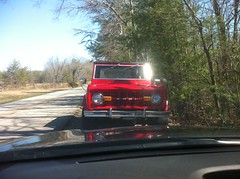
Great minds think alike.
And apparently ours do too.
Hiyo!
I'll be here all week.
I parked in a little turnout off of 28-1. And just to put it out there again... If you're riding at Bull/Jake and your route will take you by any of the lots or parking areas other than the Jake Lot, please consider parking at one of those lots rather than the Jake Lot. The horse trailers need to be able to park parallel to one another and then pull forward and around to get out, which can be dicey with a long trailer if there are a bunch of cars all the way around the outer edge.
Not 100 yards down the road, The Stronger Cyclist and his buddy Ron had just pulled in themselves. We got to talking for a few minutes but we all had big days ahead of us, in different directions, so we didn't dally about.
I headed down the road toward the Jake Lot.
It's trying really hard to be spring up there. Apparently the cold snap didn't kill the Daffodils.
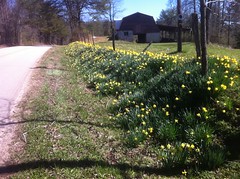
"We do not care about zis, what do you call it? 'Cold?' Bah." That's how daffodils talk.
Checkpoint 1: I measured the kiosk. 71x46-1/2.
All right then.
Onward.
I surveyed the work we'd done recently on the Bull/Jake Connector. It was holding up nicely. It did strike me though, that an unfortunate side effect of trail maintenance is that in its wake, the trail looks messy and unnatural and . I know that a year later it will look all beautiful, but I wonder if there's something that can be done at maintenance-time. Maybe we should just cover it with leaves. Something to think about I guess.
I noticed some spots on the 83 bypass that need some attention. They got bad all of a sudden. I suspect that all the rain we got this winter plus the increased popularity of the system are the culprits. The switchbacks are badly cupped, there's this one little kick near 83 too and a few other spots. Dangit.
Checkpoint 2: The sign at the Bull Lot. 69-1/2x46.
There was a guy snoozing in a Hammock at the bottom end of the lot. I wondered if he was training for the TNGA or something else but he appeared to be asleep so I didn't bother him.
I climbed Bull. About halfway up to the Y I ran into Marc Hirsch and a friend of his who's name I suddenly can't remember.
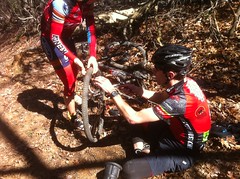
She'd flatted and they were fixing it. They'd volunteered at the Southern Cross the day before. He'd parked next to Matt and Becky that morning. Apparently it wouldn't have been possible for me to go in any direction up there that day without eventually running into somebody that I know. Man it's a small world.
Up past the Y I finally got into the section of trail that the contractor had worked on recently.
Dozens of rolling dips from the original roadbed had been restored and they all looked good. It's apparently rained a bit since the work has been done too and it was clear that the water was successfully diverted. Good to see.
There was also a LOT of this kind of thing...
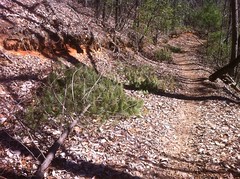
...where debris has been placed on the upslope to encourage traffic to stick to the outer edge of the road. If traffic stays to the outside, the buildup on the inside will catch sediment, new soil will form, it'll germinate, it'll blend into the backslope, sweet singletrack will emerge, substantially less work will need to be done to the rolling dips in the future... Win, win, win.
Eventually I got into the sections where the controversial work had been done. I actually rolled right through the first one without noticing it until I'd gotten through it. Bull is a net climb but there are a few short descents. The first one (past the Y at least) is eroded about two feet below grade for about 50 yards and was once very rocky and rutted. It appears that the contractors bulldozed a semi-wavy route through the rocks and now there's a smooth line with rocks to either side. In the photo that I saw a week ago, it wasn't clear why that had been done but riding into it, it became more clear. First, I don't think the contractors had finished their work when the original photos were taken. The photos showed a wide swath cut all the way up the trail but it isn't like that now. There's a distinct line now, with debris on either side and the trail meanders from the left, to the right and back to the left. I would actually like to see it meander a bit more. Maybe we'll go up and tweak it at some point. The trail used to suddenly become steep there but it's fairly gradual now.
This certainly makes the trail less challenging, but from an erosion control standpoint, it is one of the prescribed solutions. When there are precipitous changes in the pitch of the trail, water suddenly accelerates and can do a lot of very localized damage, especially if there are little ledges it can drop off of. Regrading to make the pitch more uniform helps. Meandering the trail helps too because water will tend to go straight downhill, off of the trail, into the rocks and debris on either side. As long as nobody rides through the rocks and debris on a regular basis, they will act as a silt trap, new soil will form, it'll germinate, the 8 foot wide trail will become singletrack, and so on. It DEFINITELY makes the trail less challenging, but riding into it, it was clear why it was done.
I didn't take a photo because I'd already ridden through that section and into the next one before I realized that I'd ridden through it and I was too lazy to go back. I guess that's another point though. The tread on that hill now more closely matches the tread leading up to the hill in both pitch and rugosity. I didn't notice much of a change as I rolled through it except that it was below grade. And that makes sense. One of the goals of a modern trail system is a consistent experience along the trail. It's fine for the trail to gradually become rockier and more difficult or for long sections to have distinctly different feels, but short, sudden, precipitous changes are discouraged. The rock garden that used to be there may not phase an expert mountain biker, but by rights, the trail up to that point could be comfortably ridden by an intermediate rider and rolling downhill around the corner into the rock garden could suddenly put that rider in over their head. In fact, that very thing happened to my dad when he first rode that section ten years or so ago and he crashed. Not bad, but still, he crashed. The change definitely dumbs down the trail, but it makes sense why it was done.
Almost immediately after that first hill, you roll across a flat section and climb this second one. This photo is from the top of that hill, looking back down. It's odd because whenever I take a photo from the top down, it never looks like it. I swear this is from the top, looking down.

Again, looking at it firsthand, it was clear why the contractors did what they did. There was a rut there in the past but it's been filled in and, like the previous hill, the entire hill is now a consistent grade, but more importantly, consistent with the pitch of the trail above it. This will help with erosion, which was clearly a problem before, thus the rut. Water won't suddenly accelerate or drop off of ledges any more and eat out a new rut.
Most importantly though, there is a hard left at the bottom of the hill. If a rider comes tear-assing downhill and is suddenly faced with a rutted out section of trail, his or her attention will more likely be focused directly in front of them rather than down the trail and around the corner. An expert mountain biker might be able to easily pick a line through the chunk and still be able to pay sufficient attention to notice oncoming riders but an intermediate level rider might not, or even if they did, might not be able to stop or slow down sufficiently whilst negotiating the gnar, should someone appear around that corner.
Should an oncoming hiker or cyclist appear, they might be able to get out of the way or might already be looking for someone coming down the hill and laugh it off, but Bull is an equestrian trail too and horses are wider, not generally as nimble and can throw their rider.
Some of the work could be CYA-related. "For the past 20 years there haven't been issues with people running into each other, so why do anything about it?" one might ask. The trails at Bull/Jake have been getting steadily increased use and with the improvements at Jake, that use has shot way up. Traffic is increasing, encounters are increasing, impact on the trail is increasing. There are sections that don't meet designated standards for erosion control or safety. Somebody could do all kinds of studies to decide whether it's really necessary to change anything, but it's way cheaper to make the trail compliant and if something does happen, the likelyhood of a lawsuit involving the land manager is diminished considerably because the trail was maintained to established standards.
Oh yeah, I forgot to mention. All the way up the hill following that bit of last work, the rolling dips have been restored.
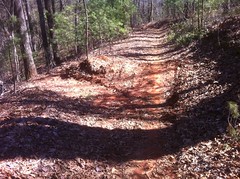
More erosion control. Combined with the turn at the bottom of the hill, and how short the section is, it's unlikely that that the corridor will rut out again any time soon even though the trail doesn't meander.
The third hill (from the bottom this time).
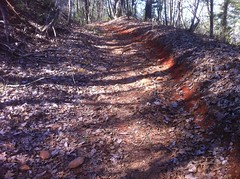
This one has been thoroughly castrated. It used to be deeply rutted, extremely challenging, and you can even see on the really far right how riders had to cling to the side to make it up the hill. In fact, old tire tracks were still visible over there when I rode through. It looks like the tread has been regraded to be consistent with the pitch above it for the same reasons discussed earlier and that the fill is chocked full of rock to armor the soil internally, similar to what was done on the trail leading up off of Jones Creek over at Jake.
This will probably erode a bit over the years, eventually, exposing the rock to some extent. There are a bunch of solutions for sections of trail like this. Ideally, you'd route around it on the outside, but that's expensive, goes outside of the corridor, might require environmental analysis, etc. I'm not really qualified to analyse this work too critically. It doesn't precisely match the solutions I learned in trail school, but it looks "OK". It certainly makes the trail easier, but it's also clear why it was done.
Bridges!

There have classically been 4 or 5 mud holes on Bull that people rode further and further around each year. Bridges have now been built over them. It definitely makes the trail easier because you don't have to sling your bike over to the side and "float". Do these count as castration? I don't know. Mud puddles are fun, but per IMBA standards, trails aren't supposed to have standing water and when they do, widening inevitably occurs. I don't think anyone would argue that widening had occurred around those mud puddles. So, again, it's clear why it was done.
The fourth hill:
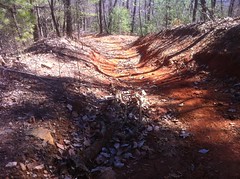
Again, this is looking down, from the top, though it may not look like it. The meandering here is really obvious, as is the rock and debris placed to either side to act as a silt trap. Again, there's a hard left at the bottom and a trail designer would want riders to slow down there without skidding and be able to focus their attention ahead. The grade is consistent with the trail above. ...All the same things as before. There's also a new water turnout at the bottom of the hill.
I actually remember this hill very well. It was so chunky that when descending it, I would hug the far right hand side and try to rail that berm way up at the top there as long as I could. To do that, I had to carry a ton of speed and I always rode into the turn below it fast and blind. It was definitely fun, and was probably reasonable to do during the Fool's Gold, but I was always reticent about doing it on a casual ride because someone could be coming the other direction. I always had to brake hard and drop down into the chunk or try to manual back and forth across it, which was a challenge, but it wasn't that much fun, at least not to me. Yeah, it's way easier now, but the work makes sense.
Fifth hill.
More of the same. There are now silt traps to either side.
Those particular sections of trail are substantially less rocky and chunky than they were in the past, but the trail as a whole is nearly as rocky as ever. Just uphill from that last hill, for example...
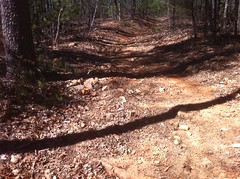
...and more beyond that.
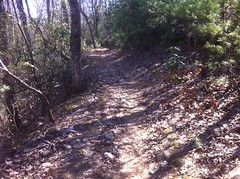
Eventually I reached the spring. There was a new turnout above it.

Most of the rock has been moved from the trail itself to the uphill side. Conditions were exactly right to suggest the motivation for this.
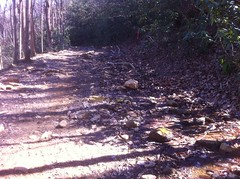
This photo is looking back up the trail. You can see how to the left, it's dry.
You don't want a spring to flow across and down the trail for any length of time. First off, it erodes the trail and sediments the creek below, in this case, a feeder of Lance Creek, a trout stream. Second, on a horse trail, there's always the possibility of suddenly introducing a good bit of e-coli into the stream if a horse drops a pile anywhere along the length of the outflow. This is one of those things though where I'm not totally sure about how big of an issue that is. It might just be more CYA, but I'm not really qualified to judge one way or another, I just know that it's a concern and work is generally done to mitigate it and that looks like what was done here.
It appears that the contractors corralled the outflow of the spring to the upslope side of the trail and made the upslope side extra rocky, encouraging traffic to take the outside, less rocky line, which is good for reasons discussed above. They did this by moving most of the rock that was on the trail itself to the inside.
Ordinarily water flowing downhill on the upper side of a trail would also be a no-no, but it's super rocky there so it's not likely to erode any significant amount and a feeder creek crosses the trail 50 yards down from the spring. The spring water just joins the feeder right there. Now, instead of riding through the outflow for 50 yards, we cross it at an armored stream crossing. Yes, the trail is dumbed down, but again, the reasons are clear and valid.
Again, as seems to happen regularly these days, I'm afforded an opportunity to study my own duality.
On the one hand, I can totally understand the frustration. "Dammit, trails everywhere are becoming really easy to ride! Where can I find a real challenge these days? Jake is a cakewalk and now and these sections of Bull are too!" I would argue that on the whole, the change in the Bull Proper experience is marginal, it's like 6 spots of maybe 50 yards each over 4 miles, but I don't ride up there every weekend. Somebody who knows the trail really well might be looking forward to individual spots, and now they've been bulldozed out of existence. And this is happening everywhere, not just at Bull and Jake. Is this the end of technical trails?
On the other hand though, I can totally understand why the work is being done and I agree with it, at least in principle. The details, eh, maybe, maybe not. It's hard to say. I'm not really qualified to say whether I like the work or not without seeing how it performs. Woody or Walt or Mike Reiter would be, but I am not them. I can say that those sections of trail are like the worst-case scenarios that they show you in trail class. The solutions we learned were much more extreme and expensive in both money and time; like rock armoring the section from top to bottom, or building up the center, outsloping that, creating an armored drain to one side and an armored turnout at the bottom, or outright rerouting. We did discuss the solutions that were employed as part of a road-trail conversion, but not specifically for a section of trail that is already below grade. I imagine they would still work though, especially for such short runs. Who knows? Time will tell.
Wretched duality! Or triality, quadrality, or whatever you want to call it.
There's really a bigger picture though. By and large, we've been riding trails with unsustainable features all our lives without realizing it or even knowing what that means. In fact, we're used to the ruggedness of the trails and enjoy it. And it seems like the trail has been like that forever, why would it suddenly matter now? Long ago most land managers defined Acceptable Limits of Change for their trails but with a few notable exceptions, were lax about even evaluating whether their trails were compliant, much less doing anything about it. Very recently there has been a push from many different directions to either catch up or close the trails and they're opting to try and catch up. Unfortunately the work that's being done necessarily de-ruggedizes trail because the very things that make sections of trail rugged are the things that make those sections non-compliant.
What we really need are trails that are technical but ALSO sustainable as opposed to trails that are technical because of their unsustainability. Currently, the only reasonable way that I know of to do that is to find naturally technical terrain and run the trail through it a la The Dug Gap Pinhoti. I would argue though, that that's the "right" way to do it. I'd like to see trails that aren't much more than a representation of the surrounding terrain that's negotiable by whatever mode of transport it's designed for. I wouldn't expect the trail to be chunky and technical if the terrain around it isn't. Similarly, I wouldn't expect to find a clean and easy trail through rough and rocky terrain. In the long term, I suspect that the solution will be to have more trails in better locations, and if we want technical trails, build them in naturally technical locations. It will take time but we'll get there eventually if, as a community, we do the right things. I'm certain though, that we won't get there if we don't first make what we already have sustainable and demonstrate that we can manage it.
The contractor's work ended at Lance Creek road and I with that, I accomplished my second objective. Yay!
Objective three was to see how well my overstuffed camelback performed. So far, so good. It kind of "sausaged out" on my back, but it didn't swing from side to side and it sat well. The only problem so far was that I didn't have room to even put my armwarmers (which I had shed by that point) in it. That's how stuffed it was. How would I fit food in there? I could unzip the compression zipper and let it expand but then I know from experience that it swings around if you do that. Hmm, maybe that "so far, so good" actually needed some revision.
The climb up Bare Hare was rocky and fun. The pack was fine, at least from a weight perspective. The descent down the back side was as fun as usual too. Again, no issues with the pack.
Well, almost.
One of my bottles slipped out of the cage.

I went back to get it, tried to bend the cage to make it a little tighter, and spraaang! it popped. I guess it was about to go and that's why the bottle fell out. Ohhh... no room in my pack. I rearranged some gear and put it in my right pocket but it fell out almost immediately.
Hmmm.
Zip ties to the rescue. I put it in the busted cage and zip-tied it to the frame. Hopefully that would hold. If I ended up needing it, I could pop the zip ties.
At the bottom of Bare Hare I rolled out on 77A, passed a few trucks and eventually made it to CP3, the kiosk at the intersection of 77A and 77.
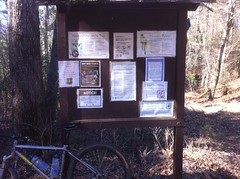
46x47
It looked pretty full though. I'm not sure how we're going to fit much else on there. That's pretty much the case with all of them actually.
The next leg was a long climb up Winding Stair Gap Road and some out-and-backs on the roads up there. I guess I could say that I had four objectives, though one of them didn't occur to me until I was near the top of Winding Stair. I noticed a few days back that I didn't have any photos on my trails site of the Hickory Flatts Cemetery, despite having been there a dozen times. How did that happen?
Easy to fix though.
The pavillion.

The graves.
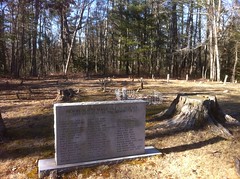
The "facilities", disgusting as they are.
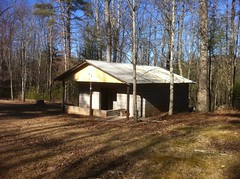
Eventually my wanderings brought me back toward the car. Not wanting my freehand nav skills to get rusty, I even did an extended hike-a-bike of what had to be a mile or more though some unfamiliar terrain. This seemed like a great idea at first, and I ended up where I intended to end up, but not before running into this punji stick.

It stuck into my leg as I walked and the force of that eventually broke it off, but the broken off point dug in pretty well. Yaah. The durability of skin never fails to amaze me. That kind of thing has happened a few times and I've always been surprised when it turns out not to have been driven directly into my shin. A few years back, Trey Woodall hit one of those and it did get driven into his shin. He pulled it out and finished his ride. Then he rode the Trans North Georgia a few weeks later. I would like to think that I would be that hard but the opportunity hasn't yet presented itself. Not that I really want it to, but I seem to keep tempting it.
A buddy of mine texted me right before I started the ride and said he was taking his kids squirrel hunting. Later he texted me that they didn't get anything but they still had a good time running around in the woods and shooting. Too bad I couldn't just text him this squirrel that I found here.

Maybe one day there will be an app for that. Da-da-ding. "Dave has sent you a squirrel."
Ha.
It was getting pretty late. The sun was gone. I had to put my armwarmers back on. You know it's been a good day if you start out wearing warm clothes, then have to take them off, but then you're still out when it gets cold enough to have to put them back on again. I turned on my flashing red tail light. I didn't yet need the headlamp.
As I approached my vehicle, I noticed Stephen's car was still there and I thought I saw someone or something milling around by mine. It turned out that he'd just finished his ride too. Nice. We'd both been out for a little over 7 hours. He was attempting to play a joke on me but I'd ridden up right then. Actually two jokes. They were pretty funny. We talked for a while and it was cool to catch up. He mentioned that he's getting chainsaw certified which will be very helpful. I know of two trees on Bare Hare that he can cut out tomorrow. We had very different rides, but they were apparently equally satisfying and at one point our paths could have crossed. I'm actually surprised that we didn't run into each other.
The experiment with the overstuffed camelback went OK. I don't think it'll be totally functional though. There's no room for anything that I might pick up along the way, like food for example. It's conceivable that I could put my bag in an even smaller stuff sack though. I'll have to try that. The experiment continues.
Oh yeah, I almost forgot. Technically I had five objectives, not four, or three. I'd put a lay-back post on my bike that morning. For a year or more, I've been bothered by how scrunched up I've been between the bars and seat. Lately it's been really bothering my neck and back. After 4 or 5 hours, especially of climbing, it gets pretty bad. I'd always had my seat as far back as possible and eventually that led to breaking a rail at the Fool's Gold last year. I got a lay-back post, originally just so I could put the seat in the same position but with the clamp further back on the rails. I eventually realized though that I needed to be further back from the bars too, so I ended up using the new post and still putting the seat really far back. I tested that out Sunday too. It made a world of difference, but I can imagine that it would be even more comfortable a half inch or more FURTHER back. Maybe I need a longer stem. I'll have to see after a race, that's when I can really tell.
Oh, what a day. The more-likely-to-be-boring part of riding around on gravel was fun, but the more-likely-to-be-fun part of riding on singletrack was work. Mark Twain points out though that work is anything one is obligated to do is and play is anything one is not obligated to do. One will even pay for the opportunity to do something that if one were paid for, one would decline, as being paid turns it into work. I think I see where he's coming from. It's weird because even the trail "work days" don't usually feel like work, yet somehow measuring the signs and examining the trail did.
Weird. So weird. Next time it will be all play.




Thanks for the informative blog post, Dave. Very enlightening.
ReplyDeleteSo you didn't descend back down Bull Proper?
One of the issues that I foresee with this trail work is that people will be coming down off the mountain with so much speed that they fail to slow down and navigate through the new "meanderings" in the old trail tread. Some of the new work could really harsh the flow, or people will end up blasting over it unknowingly.
Ah well, time will tell.
I loved this paragraph, I think this is key:
"What we really need are trails that are technical but ALSO sustainable as opposed to trails that are technical because of their unsustainability. Currently, the only reasonable way that I know of to do that is to find naturally technical terrain and run the trail through it a la The Dug Gap Pinhoti. I would argue though, that that's the "right" way to do it. I'd like to see trails that aren't much more than a representation of the surrounding terrain that's negotiable by whatever mode of transport it's designed for. I wouldn't expect the trail to be chunky and technical if the terrain around it isn't. Similarly, I wouldn't expect to find a clean and easy trail through rough and rocky terrain. In the long term, I suspect that the solution will be to have more trails in better locations, and if we want technical trails, build them in naturally technical locations. It will take time but we'll get there eventually if, as a community, we do the right things. I'm certain though, that we won't get there if we don't first make what we already have sustainable and demonstrate that we can manage it."